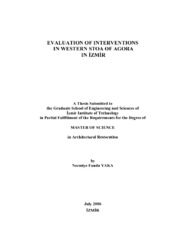Please use this identifier to cite or link to this item:
https://hdl.handle.net/11147/3426Full metadata record
| DC Field | Value | Language |
|---|---|---|
| dc.contributor.advisor | İpekoğlu, Başak | en |
| dc.contributor.author | Yaka, Necmiye Funda | - |
| dc.date.accessioned | 2014-07-22T13:51:31Z | |
| dc.date.available | 2014-07-22T13:51:31Z | |
| dc.date.issued | 2006 | en |
| dc.identifier.uri | http://hdl.handle.net/11147/3426 | |
| dc.description | Thesis (Master)--Izmir Institute of Technology, Architectural Restoration, Izmir, 2006 | en |
| dc.description | Includes bibliographical references (leaves: 134-138) | en |
| dc.description | Text in English; Abstract: Turkish and English | en |
| dc.description | xiii, 146 leaves | en |
| dc.description.abstract | Conservation implementations in archeological sites should be applied in order to better perceive the ancient remains. The implementations based on limited information must be avoided if the necessary findings are not revealed. These implementations should be executed in order not to damage the remains, should be reversible and not prevent future conservation action. Although the interventions should be compatible with original qualities with respect to form and material, they should be distinguishable from the original parts. In this study, the restoration implementations which started in 1932 and continued sporadically until 2005 in the ancient Agora of zmir are investigated. The former restoration implementations had to be reinterpreted due to new findings during the recent investigations. The aim is to introduce the restoration interventions carried out in the Agora/West Stoa, and to evaluate them regarding present conservation approaches. Architectural findings of the excavation are examined, documentation studies are performed through field surveys, in addition original building components and lateral interventions are analyzed. In the evaluation, distinguishability of the new application, the compatibility of the materials used and proper techniques, with existing materials, the availability for future applications and reversibility of present interventions in order to allow necessary rectification in future are taken into consideration. Accordingly, the interventions between 1932 and 1944 are evaluated reversible and distinguishabile while materials and techniques applied in the interventions are not compatible with the original. The implementations applied between 2002 and 2005, are evaluated distinguishable, compatible with original materials and techniques, available for future studies and reversible. | en |
| dc.language.iso | en | en_US |
| dc.publisher | Izmir Institute of Technology | en |
| dc.publisher | Izmir Institute of Technology | en_US |
| dc.rights | info:eu-repo/semantics/openAccess | en_US |
| dc.subject.lcc | NA9053.C6 .Y15 2006 | en |
| dc.subject.lcsh | Historic sites--Turkey--Conservation and restoration | en |
| dc.subject.lcsh | Excavations (Archaeology)--Turkey--Conservation and restoration | en |
| dc.title | Evaluation of interventions in Western Stoa of Agora in Izmir | en_US |
| dc.type | Master Thesis | en_US |
| dc.authorid | TR132914 | |
| dc.institutionauthor | Yaka, Necmiye Funda | - |
| dc.department | Thesis (Master)--İzmir Institute of Technology, Conservation and Restoration of Cultural Heritage | en_US |
| dc.relation.publicationcategory | Tez | en_US |
| item.languageiso639-1 | en | - |
| item.fulltext | With Fulltext | - |
| item.openairecristype | http://purl.org/coar/resource_type/c_18cf | - |
| item.openairetype | Master Thesis | - |
| item.grantfulltext | open | - |
| item.cerifentitytype | Publications | - |
| Appears in Collections: | Master Degree / Yüksek Lisans Tezleri | |
Files in This Item:
| File | Description | Size | Format | |
|---|---|---|---|---|
| T000520.pdf | MasterThesis | 15.02 MB | Adobe PDF |  View/Open |
CORE Recommender
Page view(s)
104
checked on Jul 22, 2024
Download(s)
112
checked on Jul 22, 2024
Google ScholarTM
Check
Items in GCRIS Repository are protected by copyright, with all rights reserved, unless otherwise indicated.